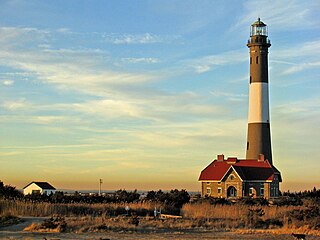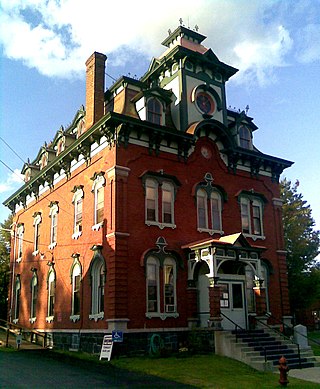
Port Henry is a hamlet in Essex County, New York, United States. The population was 1,194 at the 2010 census.

The Fire Island Lighthouse is a visible landmark on the Great South Bay, in southern Suffolk County, New York on the western end of Fire Island, a barrier island off the southern coast of Long Island. The lighthouse is located within Fire Island National Seashore and just to the east of Robert Moses State Park. It is part of the Fire Island Light Station which contains the light, keepers quarters, the lens building containing the original first-order Fresnel lens, and a boat house.

This is intended to be a complete list of properties and districts listed on the National Register of Historic Places in Orleans County, New York. The locations of National Register properties and districts may be seen in a map by clicking on "Map of all coordinates". Two listings, the New York State Barge Canal and the Cobblestone Historic District, are further designated a National Historic Landmark.

This list is intended to be a complete compilation of properties and districts listed on the National Register of Historic Places in Rensselaer County, New York, United States. Seven of the properties are further designated National Historic Landmarks.

Winehaven was a winery and town in Richmond, California, that held the title of "world's largest winery" for 12 years (1907–1919). It later became a fuel depot for the United States Navy.

Oyster Bay is the terminus on the Oyster Bay Branch of the Long Island Rail Road. The station is located off Shore Avenue between Maxwell and Larabee Avenues. It is a sheltered concrete elevated platform that stands in the shadows of the original station, which was accessible from the ends of Maxwell, Audrey, and Hamilton Avenues. Both stations exist along the south side of Roosevelt Park.

The Great Atlantic and Pacific Tea Company Warehouse is a historic formerly commercial building at 150 Bay Street in Jersey City, Hudson County, New Jersey, United States. Built as a warehouse for The Great Atlantic & Pacific Tea Company (A&P) in 1900, it is the major surviving remnant of a five-building complex of the nation's first major grocery store chain. It was designated a National Historic Landmark in 1978, and now houses a mix of residences and storage facilities.

The Park Avenue House is a high rise residential building located at 2305 Park Avenue in the Park Avenue Historic District in Downtown Detroit, Michigan. It was listed on the National Register of Historic Places in 1996. It should not be confused with the nearby Park Avenue Hotel, which was demolished in 2015.

The American Bank Note Company Building is a five-story building at 70 Broad Street in the Financial District of Manhattan in New York City. The building was designed by architects Kirby, Petit & Green in the neo-classical style, and contains almost 20,000 square feet (1,900 m2) of space, with offices and residences on the upper floors. The exterior consists of a main facade on Broad Street with two columns, as well as side facades with pilasters on Beaver and Marketfield Streets.

The Hudson and Manhattan Railroad Powerhouse, also known as the Jersey City Powerhouse in Jersey City, Hudson County, New Jersey, United States, was built in 1908. The powerhouse made possible the subway system between New Jersey and New York for the Hudson and Manhattan Railroad. It was built under the leadership of William Gibbs McAdoo, president of the railroad. The powerhouse was closed in 1929 and used as a storage place for railroad equipment. In the 1990s, the building was cited by Preservation New Jersey as one of the state's ten most endangered historic sites. The powerhouse was added to the National Register of Historic Places on November 23, 2001, for its significance in architecture, engineering, and transportation.

The District #2 Schoolhouse, known locally as the Garfield School and also known as Brunswick District No. 2 School, located in Brunswick, New York, United States, is a two-room schoolhouse built and opened in 1881. It hosted local students until the consolidation of Brunswick (Brittonkill) Central School District in the mid-1950s. It was added to the National Register of Historic Places (NRHP) in 1988, becoming the first building in the Town of Brunswick to be added to the Register. It is the current home of the Brunswick Historical Society.

There are 75 properties listed on the National Register of Historic Places in Albany, New York, United States. Six are additionally designated as National Historic Landmarks (NHLs), the most of any city in the state after New York City. Another 14 are historic districts, for which 20 of the listings are also contributing properties. Two properties, both buildings, that had been listed in the past but have since been demolished have been delisted; one building that is also no longer extant remains listed.

Mount Moriah Presbyterian Church, also known as First Presbyterian Church, is a historic Presbyterian church located at Church and S. Main Sts., NW corner, Town of Moriah in Port Henry, Essex County, New York. It was built in 1888 and is a distinguished example of Richardsonian Romanesque architecture. It is rectangular in plan and constructed of dark sandstone. It features an unusual two story, hipped roof, combination porte cochere and bell tower.

Peterboro Street Elementary School is a historic elementary school building located at Canastota in Madison County, New York. It was built in 1927 in the Gothic Revival style. It is a large brick and concrete building whose front facade features a broad, projecting central pavilion flanked by broad, two bay wings.

Moriah Town Office Building is a historic town hall building, located at Port Henry in Essex County, New York, built in 1875. It is a massive, 3-story rectangular, five-by-three-bay, brick building capped by a concave mansard roof in the Second Empire style. It features three tall brick chimneys with molded caps, symmetrically placed gable dormers, and a square roof-top cupola. Also on the property are a carriage house and modest clapboard-sided building, used as a court house. It was built as the main office of Witherbee, Sherman, and Company and obtained for use as town offices in May 1959.

Paul Smith's Electric Light and Power and Railroad Company Complex is a national historic district located at Saranac Lake in Franklin County, New York. It contains two contributing buildings and two contributing structures. The powerhouse was built in 1908-1909 and is a one-story, single room brick building on a stone foundation measuring 40 feet by 55 feet. The office building was built in 1927 and is a three-story steel and masonry building with a terra cotta exterior. It is three bays wide by four bays deep. The Main Street Bridge is a concrete slab bridge built between 1924 and 1931. The Lake Flower Dam and Power Flume was built between 1936 and 1938 with Works Progress Administration assistance.

The Harry Belafonte 115th Street Branch of the New York Public Library is a historic library building located in Harlem, New York City. It was designed by McKim, Mead & White and built in 1907–1908 and opened on November 6, 1908. It is a three-story-high, three-bay-wide building faced in deeply rusticated gray limestone in a Neo Italian Renaissance style. The branch was one of 65 built by the New York Public Library with funds provided by the philanthropist Andrew Carnegie, 11 of them designed by McKim, Mead & White. The building is 50 feet wide and features three evenly spaced arched openings on the first floor. The branch served as Harlem cultural center and hub of organizing efforts.

Joseph W. Catharine School is a historic elementary school located in the Mount Moriah neighborhood of Philadelphia, Pennsylvania. It is part of the School District of Philadelphia. The building was designed by Irwin T. Catharine and built in 1937–1938. It is a three-story, six bay, yellow brick in the Moderne-style. It features a main entrance with decorative stone surround, stone sills, and stone coping atop the building.
This is a timeline and chronology of the history of Brooklyn, New York. Brooklyn is the most populous of New York City's boroughs, and was settled in 1646.






















